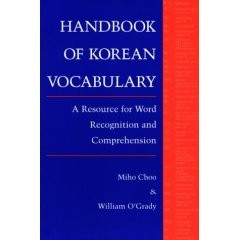
inkl. MwSt. zzgl. Versandkosten
- Art.Nr./ISBN: 9780824818159
- Verlag: University of Hawaii Press
- Jahr: 1996
- Einband: Softcover
- Seitenzahl: 388
- Sprache: Korean, English
- Medientyp: Buch
Auf Lager. Versandfertig in 1-3 Werktagen
This "root dictionary" of Korean for second language learners contains more than 1500 vocabulary lists consisting of words built from a shared root. Upon encountering a word, the student can consult the list for its component roots and discover other semantically related words.
By the Authors: The Handbook is useful for beginning students too!
As the authors of The Handbook of Korean Vocabulary, we have been very gratified by the overwhelmingly positive response that our book has received since its publication, both from reviewers and from students who have been using it to improve their knowledge of Korean vocabulary. However, we would like to take issue with a point that has been made in recent reviews. That has to do with the suitability of our book for beginning students. While we certainly agree that the book is very useful for intermediate and advanced students, we nonetheless believe that it also contains information that could be extremely helpful to even first-year students. Think, for instance, of the first vocabulary items that a typical beginning student learns--words like 'hakkyo' (school), 'haksayng' (student), 'sensayngnim' (teacher), 'yenphil' (pencil), 'chayk' (book) and so forth. As it turns out, each and every one of these has entries in the Handbook that lead to a number of other very useful words. For instance, 'chayk' leads to a list that contains 'chaykpang' (bookstore), 'kongchayk' (notebook) and 'chayksang' (desk). And, of course, both 'hakkyo' and 'haksayng' contain the 'hak' root that shows up in many other useful words as well. So as useful as the Handbook is for students at the intermediate and advanced level, we remain convinced that it is also vital for beginning students. In fact, by revealing to them some of the systematicity and regularity in Korean vocabulary, it can actually help them reach the intermediate and advanced levels more rapidly than they otherwise would.
University of Hawaii Press



















